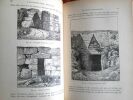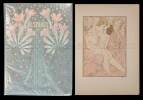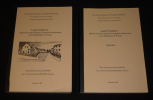-
Type
Any type (2)
Art print (7)
Book (30848)
Disk (1)
Drawings (7)
Engraving (9)
Magazine (129)
Old papers (1)
Photographs (14)
Posters (4)
-
Latest
Last 24h (4)
Last 3 days (7)
Last month (229)
Last week (129)
-
Language
Dutch (1)
English (54)
French (30921)
German (6)
Italian (18)
Japanese (2)
Portuguese (9)
Spanish (11)
-
Century
16th (16)
17th (56)
18th (209)
19th (1540)
20th (9203)
21st (1660)
-
Countries
Belgium (9485)
Brazil (7)
Canada (108)
China (3)
Côte d'Ivoire (67)
Denmark (218)
France (18069)
Germany (1)
Greece (1)
Italy (37)
Switzerland (3026)
-
Syndicate
ALAC (99)
CLAM (42)
CLAQ (94)
CNE (3)
ILAB (10650)
NVVA (1161)
SLACES (1161)
SLAM (8122)
SNCAO (9)
Graphic Art of the Pre-impressionists
, Harry N. Abrams, Inc 1981, 1981 Hardcover, 295 pages, English, 340 x 250 mm, Illustrated., Fine copy. ISBN 9780810909755.
Presumed First American edition. Quarto. Brown cloth boards. Translated by Robert Erich Wolf. Illustrated with black and white plates. Very good with very slightly bowed boards, lightly worn board edges, a few faint board stains in a very good (plus) dustwrapper with a one-inch tear along the crown, rubbing and edge wear. Including works by Boudin, Corot, Daubigny, Dupr , Jongkind, Millet, and Rousseau. Originally published in France, under the title *Les grands graveurs*.
L'ABBAYE DE FONTEVRAULT
Henri Laurens - Jacques Lanore. 1971. In-12. Broché. Bon état, Couv. convenable, Dos satisfaisant, Intérieur frais. 115 pages. Illustré de nombreux plans et photos en noir et blanc, dans et hors texte.. . . . Classification Dewey : 720-Architecture
'Petites Monographies des Grands Edifices de la France', dir. par Michel Fleury. 15 plans et 76 photographies. Classification Dewey : 720-Architecture
Nouvelles Alexandries. Les grands chantiers de bibliothèques dans le monde.
Paris Editions du Cercle de la Librairie, coll. "Bibliothèques" 1996 1 vol. relié in-4, cartonnage toilé sous jaquette illustrée, 399 pp., nombreuses photos en noir et en couleurs. Excellent état, proche du neuf.
MARTEN MELSEN 1870 - 1947, monografie.
, Antwerpen, Pandora, 2003, Gebonden in linnen met stofomslag, 25x30cm, 177 PAGINA4S , ge llustreerd. nieuwstaat. ISBN 9789053252246.
Het sappige oeuvre van de Brusselaar Marten Melsen vertolkt picturaal en humoristisch het leven van de boer op het platteland. Melsen schildert op meesterlijke wijze zijn breugeliaanse boerentaferelen meelevend, ongedwongen en humoristisch, soms bijna karakturaal.Schilder van het sappige boerenleven is Marten Melsen (Stabroek 1870-1947) de polderschilder bij uitstek. Ter gelegenheid van drie belangrijke tentoonstellingen (Jacob Smits museum Mol, Stedelijk Museum Oostende en Breda) verschijnt deze eerste publicatie ooit over Marten Melsen. Tevens omvat het boek de oeuvre catalogus van het grafisch werk van de kunstenaar. Melsen, peintre et aquarelliste de genre, de figures et de paysages, etait eleve de l'Academie de Bruxelles, dans l'atelier de J. Stallaert. Il peint la Campine et les polders. Membre du groupe 'Als ik kan' (1886). Membre fondateur du 'cercle Labeur' (1898) et de 'Kunst van Heden' (1905). Sejourne en Angleterre pendant la premiere guerre mondiale. Realise les peintures des plafonds pour l'opera d'Anvers en 1907.
Eglises et chapelles du Jura bernois. Précis historique et étude descriptive. ‘Eglises catholiques du diocèse de Bâle’, 4.
Olten, Otto Walter, 1938, gr. in-4°, XVI + 368 p., très abondamment illustré dans le texte d'illustrations photographiques reproduites en héliogravure, avec 2 cartes dépliantes (du Jura et de la ville de Porrentruy), Prix de religion en 1948 de l’ ‘École secondaire de la Broye’ pour ‘René Brossard’ + une photographie originale de classe (17x21.5 cm) ‘Baccalauréat 1952 St.-Michel Fribourg’ signé au verso ‘R. Brossard’, solide reliure en toile originale grise de l'éditeur, armoiries de l'évêque de Bâle estampées sur le plat supérieur avec le titre
Bibliographie jurassienne n° 2541.

(SLACES, NVVA)
Phone number : 41 (0)26 3223808
Vers la révolution de l'art religieux dans le Jura bernois.
Dakar, IFAN, Institut Français d’Afrique Noire 1963, 215x150mm, 198pages, broché. Bel exemplaire.
photos n/b, Pour un paiement via PayPal, veuillez nous en faire la demande et nous vous enverrons une facture PayPal
Vieux monastères de Porrentruy.
Porrentruy, 1951, 245x185mm, 76pages, broché.
photos n/b, Pour un paiement via PayPal, veuillez nous en faire la demande et nous vous enverrons une facture PayPal
Vieux monastères de Porrentruy.
Porrentruy, 1951, 235x170mm, 76pages, cartonnage de l’éditeur, dos toilé.
photos n/b, Pour un paiement via PayPal, veuillez nous en faire la demande et nous vous enverrons une facture PayPal
Eglises et chapelles du Jura Bernois. Précis historique et étude descriptive. Eglises catholiques du Diocèse de Bâle, tome 4.
Olten, O. Walter 1938, 300x210mm, 368pages, nombreuses illustrations, 2 plans dépliants, reliure de l’éditeur. Taches brunes sur la page de garde supérieure.
Pour un paiement via PayPal, veuillez nous en faire la demande et nous vous enverrons une facture PayPal
MAISONS SCOLAIRES - PREMIERS BILANS - MAISONS PASSIVES / MAISONS A MUR TROMBE / MAISONS A CAPTEURS A AIR / MAISONS A CAPTEUR A EAU / D AUTRES CHOIX / CONCLUSION / VOCABULAIRE TECHNIQUE / ETC.
EDITIONS DU MONITEUR. 1980. In-4. Broché. Bon état, Couv. convenable, Dos satisfaisant, Intérieur frais. 207 pages augmentées de nombreuses illustrations en couleur et noir et blanc dans et hors texte -Texte sur plusieurs colonnes -. . . . Classification Dewey : 720-Architecture
SOMMAIRE : MAISONS PASSIVES / MAISONS A MUR TROMBE / MAISONS A CAPTEURS A AIR / MAISONS A CAPTEUR A EAU / D AUTRES CHOIX / CONCLUSION / VOCABULAIRE TECHNIQUE / ETC. Classification Dewey : 720-Architecture
Mémoire sur quelques anciens monumens du Comté Vénaissin.
S.l.n.d. (1768) in-8 carré, paginé 739 à 764, broché, papier marbré moderne. Rousseurs, mouillures.
Extrait des Mémoires de Littérature tirés des registres de l'Académie royale des inscriptions et belles lettres, tome 32, 1768."L'Opinion énoncée dans cette dernière dissertation, et d'après celui qui concerne l'arc de triomphe d'Orange, a été combattue par M. Fortia d'Urban, dans l'Art de vérifier les dates avant JC, à l'art. de l'histoire romaine." Quérard, tome 6, 1834, p.34. - - VENTE PAR CORRESPONDANCE UNIQUEMENT - LIEN DE PAIEMENT, NOUS CONSULTER.
HISTOIRE DES BEAUX ARTS. ART MODERNE. ARCHITECTURE, SCULTURE, PEINTURE, ERT DOMECTIQUE.
DELAGRAVE.. 1894. In-12. Cartonnage d'éditeurs. Etat d'usage, Couv. légèrement passée, Dos frotté, Intérieur acceptable. 396 pages. Note au stylo sur la page de garde.. . . . Classification Dewey : 720-Architecture
Classification Dewey : 720-Architecture
Histoire des Arts Décoratifs - La Décoration au XVIe siècle, le style Henri II - La décoration au XVIIe siècle, le style Louis XIV - La décoration au XVIIIe siècle (2 tomes) le style Louis XVI, le style Louix XV
PARIS, J. Rouam éditeur, Bibliothèque populaire des écoles de dessin - 1884 - In-12, 115 x 160 mm - Reliure cartonnée de l'éditeur - 34, 33, 31 & 32 figures, certaines PP - 80, 71, 74 & 74 pages - quelques rousseurs - bon exemplaire
- Livraison a domicile (La Poste) ou sur simple demande en Mondial Relay.- ATTENTION: Colis recommandé uniquement sur demande (parcel recommended on request). Si vous désirez un remboursement équivalent au montant de votre achat, en cas de perte détérioration ou spoliation, demandez-nous expressément un envoi en recommandé ( if you wish a repayment equivalent to the amount of your purchase, in case of loss - deterioration or despoliation, ask us expressly for a sending recommended)- Conditions de vente : Les frais de port sont affichés à titre Indicatifs (pour un livre) Nous pouvons être amené à vous contacter pour vous signaler le surcoût du au nopmbre de livres achetés ou du poids de ceux-ci. - Conditions of sale : The shipping costs are displayed as an indication (for one book) We may need to contact you to inform you of the cost of the additional shipping depending on the weight and the number of books- Possibilité d'envoi par Mondial-Relay - Réception en boutique sur rendez-vous. Librairie G. PORCHEROT - SP.Rance - 0681233148
Histoire des Arts Décoratifs - La Décoration en Grèce - Complet en 2 tomes - I) Architecture et sculpture - II) Meubles et vêtements
PARIS, J. Rouam éditeur, Bibliothèque populaire des écoles de dessin - 1884 - In-12, 115 x 160 mm - Reliure cartonnée de l'éditeur - 40 & 62 figures, certaines PP - 80 & 74 pages - quelques rousseurs - bon exemplaire
- Livraison a domicile (La Poste) ou sur simple demande en Mondial Relay.- ATTENTION: Colis recommandé uniquement sur demande (parcel recommended on request). Si vous désirez un remboursement équivalent au montant de votre achat, en cas de perte détérioration ou spoliation, demandez-nous expressément un envoi en recommandé ( if you wish a repayment equivalent to the amount of your purchase, in case of loss - deterioration or despoliation, ask us expressly for a sending recommended)- Conditions de vente : Les frais de port sont affichés à titre Indicatifs (pour un livre) Nous pouvons être amené à vous contacter pour vous signaler le surcoût du au nopmbre de livres achetés ou du poids de ceux-ci. - Conditions of sale : The shipping costs are displayed as an indication (for one book) We may need to contact you to inform you of the cost of the additional shipping depending on the weight and the number of books- Possibilité d'envoi par Mondial-Relay - Réception en boutique sur rendez-vous. Librairie G. PORCHEROT - SP.Rance - 0681233148
Histoire des Beaux Arts-Moyen Age
architecture, sculpture, peinture arts domestique. In 12 broché, faux-titre, titre, 322 pages, 1 page de table des matières. Paris Librairie Delagrave sans date.
Le TRAVAIL dans l'ANTIQUITE. Tome I : Agriculture, industrie (1 volume) - Tome II : Architecture, commerce, beaux-arts (1 volume). Nouvelle édition publiée par Edouard Rouveyre, avec sommaires analytiques et index des noms propres cités. Accompagné de 390 (et 400) documents reproduits d'après les monuments originaux.
1913 P., Flammarion, 1913, 2 volumes in 8° brochés, VII-331 et VIII-344 pages ; 790 illustrations in-texte ; qq. rousseurs, mouillure angulaire aux derniers cahiers du tome II ; couvertures légèrement fanées, le plat inférieur du tome II manque.
Constituent les tome V et VI de la Collection "Vie privée des Anciens". ...................... Photos sur demande ..........................


Phone number : 04 77 32 63 69
La Vie Privée des Anciens.- Le Travail dans l'Antiquité : Architecture, Commerce, Beaux-Arts.
Ernest Flammarion, 1928. In-8 relié (20,8 x 14,5 cm), reliuredemi-basane caramel, titre doré sur le dos, couverture originale conservée, VIII-344 pages, illustré de 388 figures gravées dans le texte.- 880g. - Très bon état.
RUDI SPANZEL
, Alpine Fina Arts Collection, LTD 1987, 1987 Hardcover, 199 pages, English, 295 x 225 mm, fine copy, with very different illustrations of this artist, with autographs of the artist and Luc Menase,. ISBN 9780881681291.
Rudi panzel graduated from the Academy of Fine Arts in Ljubljana. He is one of the few contemporary painters who create on the principle of Renaissance artists, who have insisted on realism and deep symbolism. He has received many domestic and foreign awards for achievements, among them the Pre?eren Fund Award in 1985. He painted portraits on Slovenian tolar banknotes, in circulation from October 1991 until the introduction of euro in January 2007
lidova architecktura v Ceskoslovensku
Academia nakladatelstvi 1980 Livre en Tchèque In-4 relié 29 cm sur 23. Jaquette en bon état. Bon état d’occasion.
Architecture folklorique en Tchécoslovaquie Bon état d’occasion
Onze cents années d'architecture en Tchécoslovaquie
PRAGUE, Administration des Monuments Historiques - Sans date, 1950 (?) - In-4 - couverture illustrée - 35 pages avec illustrations en texte + 24 pages d'illustrations PP - Bon exemplair"e
Monographie de la Tchécoslovaquie à travers son architecture - Livraison a domicile (La Poste) ou sur simple demande en Mondial Relay.- ATTENTION: Colis recommandé uniquement sur demande (parcel recommended on request). Si vous désirez un remboursement équivalent au montant de votre achat, en cas de perte détérioration ou spoliation, demandez-nous expressément un envoi en recommandé ( if you wish a repayment equivalent to the amount of your purchase, in case of loss - deterioration or despoliation, ask us expressly for a sending recommended)- Conditions de vente : Les frais de port sont affichés à titre Indicatifs (pour un livre) Nous pouvons être amené à vous contacter pour vous signaler le surcoût du au nopmbre de livres achetés ou du poids de ceux-ci. - Conditions of sale : The shipping costs are displayed as an indication (for one book) We may need to contact you to inform you of the cost of the additional shipping depending on the weight and the number of books- Possibilité d'envoi par Mondial-Relay - Réception en boutique sur rendez-vous. Librairie G. PORCHEROT - SP.Rance - 0681233148
Wummy - Der gute Elefant. Originalillustrationen zur Werbezeitschrift der Firma «Elefanten-Schuh»
Kleve, ca. 1960/1980. & 61 Positionen (Mappen) mit über 300 Originalzeichnungen und vielen Druckvorlagen. Dazu ein sich bewegender Schaufenster-Animationselefanten und ein Wummy-Plüschelefanten.
Bildergeschichten für die Comic-Zeitschrift "Wummy der gute Elefant. Eine lustige Zeitung für unsere jungen Kunden. Herausgegeben von der Elefanten-Schuh GmbH Kleve" - Die Firma „Elefanten-Schuh" in Kleve wurde 1896 von Gustav Hoffmann(1872-1935) und seinem aus Berlin stammenden Schwager Fritz Pannier (1867 - 1943) gegründet. Sie entwickelte sich in den Folgejahrzehnten zum führenden Kinderschuhproduzenten in Europa. Ihre Sonderstellung beruhte auf einer geradezu sensationellen Erfindung der beiden Firmengründer: dem anatomisch geformten rechten und linken Kinderschuh. Bis dahin gab es nur den Einheitsleisten, einen Unterschied zwischen rechtem und linkem Fuss kannte man nicht. Die Produktion in Kleve selbst wurde dann 1997 beendet. Im Jahr 2001 übernahm die britische Firma CLARKS das Unternehmen. Der „Rote Elefant", das Markenzeichen, verschwand von allen Briefbögen. Das Logo aber gibt es noch heute bei der Unternehmensgruppe Deichmann. Als kindgerechten und kostenlosen Werbeartikel erfand man schon zu Beginn der 1930er Jahre eine Kinderzeitschrift, die „ELEFANTEN-ZEITUNG". Die Schriftleitung hatte Rudi vom Endt (1892-1966). Er war auch als Zeichner verantwortlich. Mit leicht verändertem Titel erschien diese vier- bis achtseitige Werbezeitschrift wahrscheinlich bis Kriegsbeginn 1939. Die tragenden Serienfiguren waren die Elefanten Knix und Knax. Im gesamten deutschsprachigen Raum wurden die Hefte vertrieben. Nach dem Krieg, ab Mitte der 50er Jahre, erfuhr die Zeitschrift eine Neuauflage. Für 4 Seiten Text und Illustration zeichnete ein Anonymus mit dem Kürzel „L" und „LE" verantwortlich. Gedruckt wurde bei A. Bagel in Düsseldorf. Es gab auch eine zweiseitige Beilage „Für das Elefantenküken", bildstilistisch verwandt den Illustrationen von Else Wenz-Vietor in den 20er und 30er Jahren. Einen inhaltlich und zeichnerisch neuen Anfang wagte man 1969. Mit der Oktober-Nummer dieses Jahres war die Düsseldorfer Graphikerin Lieselotte Mende (1923-2012) betraut. Ob sie auch die Texterin war ist nicht bekannt. Mende blieb die verantwortliche Designerin bis in die 1980er Jahre. Der Umfang der Hefte wurde wieder auf 8 Seiten erweitert und dem Titel „ DER GUTE ELEFANT" ein „WUMMY" davorgestellt. Wummy, das stand für Kraft und Stabilität und Strapazierfähigkeit. Und einen besseren Sympathieträger als WUMMY konnte man sich schwerlich vorstellen. Gedruckt wurde bei der Firma Bösmann in Kleve. Das war redaktionstechnisch eher umständlich, mussten doch alle Entwürfe und Korrekturen bis hin zum fertigen Layout von Düsseldorf nach Kleve (und zurück) zeitaufwendig geschickt werden. Das geschah in zweimonatigem Erscheinungsrhythmus. „WUMMY" war beliebt und werbewirksam. Neben seiner nachlesbaren und augenscheinlichen Präsenz in der Zeitschrift gab es ihn auch als kaufbares Plüschtier. Und potentielle Käufer wurden auf ihn auch aufmerksam durch einen im Schaufenster befindlichen, mit einem Elektromotor betriebenen Aufsteller: Zwei Purzelbaum schlagende Elefanten an einem Reck. Was die Zeitschrift selber angeht war ein neuer, forscherer „Strich" zu beobachten. Lieselotte Mende liess die ehemals etwas behäbige Bildsprache der 30er und 50er Jahre vergessen. Ihr Stil war eher dem Duktus der Disney-Ära verpflichtet, frischer, zeitnäher, dramaturgisch geschickt. Dass sich eine Kollektion wie die hier vorliegende mit den Mendeschen Originalzeichnungen, ihrem Layout sowie den entsprechenden gedruckten Exemplaren durch Zufall erhalten hat und gefunden wurde, ist bemerkenswert und erfreulich zugleich.

Phone number : 41 (0)44 261 57 50
Holy Places, Sacred Sites. A Journey to the World’s Most Spiritual Locations. Photographs, Foreword and Captions Eduardo Rubio Méndez. Introduction, Text and Epilogue Juan Masia Clavel.
London, Thames & Hudson, 2008, gr. in-4to, 240 p., richly ill. with full coloured photographs, original publ. binding, orig. jacket ill. in colour.

(SLACES, NVVA)
Phone number : 41 (0)26 3223808
Hespérus.
Paris, Société de propagation des livres d'art, 1904. 4°. 96 S., (2) Bl. Mit 13 farb. Tafeln und reicher Buchschmuck von Carloz Schwabe. Farb. illustr. Orig.-Broschur mit Pergamin-Schutzumschlag.
Monod 8030. – Nr. 162 von total 165 Exemplaren. Sehr schön gestaltetes Werk mit Illustrationen des deutsch-schweizerischen Künstlers Carlos Schwab (1866–1926).
Silhouette de Seurat.
, Kroller-Muller Museum, 1994 relie, 83 pages, Illustrated. Texte en Francais. ISBN 9074453139.
catalogue exposition
Loger l'employé : maîtrise d'ouvrage syndicale et modernité architecturale sous la République de Weimar (2 volumes)
Université Paris I Panthéon-Sorbonne Dos carré collé 1994 Deux volumes in-4 (20,8 x 29,6 cm), dos thermocollé, pagination continue, 791 pages pour le volume de texte, volume d'annexes non paginé, document tapuscrit, thèse universitaire dirigée par Gérard Monnier publiée en 2010 aux Publications de la Sorbonne ; quelques petites rousseurs sur les tranches supérieures, par ailleurs bon état. Livraison a domicile (La Poste) ou en Mondial Relay sur simple demande.
 Write to the booksellers
Write to the booksellers











